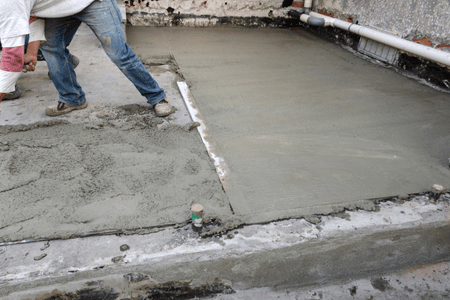Concrete forms the backbone of Texas homes and commercial buildings. You'll find it in driveways, patios, sidewalks, and building foundations. But even this tough material isn't bulletproof. Over time, concrete cracks, chips, and other damage can appear, threatening both looks and safety.
Concrete restoration fixes and renews existing concrete without full replacement. It's a cost effective way to repair structural issues and refresh surfaces that have seen better days. As America's infrastructure ages, concrete restoration has become vital. The global market grew from $24.8 billion in 2024 to $26.6 billion in 2025 as property owners choose to restore and extend the life of concrete rather than rebuild.
This guide explains what concrete restoration involves and why it matters for safety and appeal in Texas.
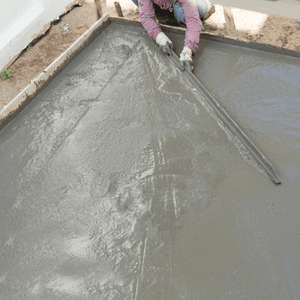
Concrete restoration uses proven methods to fix, resurface, and revive existing concrete. Instead of tearing everything out, contractors perform concrete repair, smooth uneven surfaces, and apply finishes to enhance durability and aesthetics. It’s a cost-effective solution for commercial buildings, floors, patios, sidewalks, and driveways in TX.
This process restores both strength and original appearance. From structural repair to concrete surface preparation and stained concrete finishes, professionals bring new life to aging surfaces using proper materials, equipment, and tools. These services extend to bridges, floors, and other construction elements where concrete repair is essential.
For customers across TX, concrete repair services help preserve the integrity of valuable structures. Whether working on a building or exterior space, contractors focus on doing a complete and lasting job. With a commitment to quality services, professionals ensure that each project improves appearance, performance, and safety. Satisfied customers rely on expert services for long-term results.
Even durable concrete eventually wears down. In Texas, damage often stems from extreme conditions that demand timely concrete repair or full concrete restoration.
Soil movement is a major culprit. Texas clay swells and shrinks with moisture, stressing concrete slabs. Heat dries soil fast, causing it to pull away from foundations and trigger settlement or structural issues.
Weather extremes also take a toll. Heat and cold make concrete expand and contract. Repeated freeze-thaw cycles can cause spalling and damaged concrete surfaces.
Moisture causes deeper problems by corroding rebar inside concrete. Expanding rust weakens the structure and harms appearance.
Poor construction or overloading accelerates wear. In TX, resurfacing helps avoid full replacement. Contractors enhance floors, sidewalks, or a concrete patio with stained concrete, restoring form and function while improving appeal.
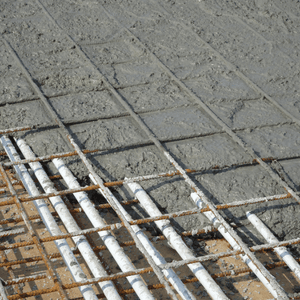
Repairing damaged concrete is about more than aesthetics—it’s crucial for safety, durability, and long-term value.
Structural issues can escalate fast. Spalling concrete or loose pieces on commercial buildings or garages may indicate corroded steel rebar and serious risks. Prompt concrete repair keeps people safe and preserves stability.
Concrete restoration extends structure life. Sealing damage and resurfacing prevent water intrusion, saving structures from premature failure. It’s far more cost effective to repair than replace concrete slabs or patios entirely.
Restoration cuts costs. Delayed maintenance often leads to expensive projects. Early fixes prevent full rebuilding.
Improved concrete surfaces boost curb appeal. Sidewalks, stained patios, and floors look new again, enhancing aesthetics and market value.
Timely work prevents hazards. Contractors restore surfaces to their original appearance while protecting customers and properties across TX.
Professional contractors use efficient methods and modern materials for lasting repairs. Texas concrete restoration experts rely on industry standards to deliver high quality services that restore both form and function.
Every concrete restoration project starts with thorough evaluation of concrete surfaces. Professionals inspect damaged concrete structures to identify all problem areas and determine underlying causes. This assessment is critical to formulating proper concrete repair plans for commercial and residential properties.
Proper surface preparation is arguably the most important step in Texas concrete restoration. Areas to be repaired must be cleaned so new substances bond effectively to old concrete surfaces. This involves pressure washing or sandblasting to remove dirt, oil, and loose debris. Crumbling concrete gets chipped away using hammers, chisels, or jackhammers until sound concrete is exposed.
For structural concrete repair, epoxy injection is common. Technicians inject liquid epoxy resin into cracks under pressure. The epoxy fills crevices and hardens, essentially welding damaged concrete back together. For concrete spalling, concrete repair involves removing loose concrete until solid material is reached. Exposed rebar gets cleaned of rust and coated with corrosion-inhibiting compounds. Areas are then patched with special repair mortar.
After structural defects are repaired, many Texas concrete restoration jobs include improving top concrete for uniform appearance. Resurfacing involves applying thin overlays or coatings over entire surfaces. Driveways with widespread minor pitting can get cementitious overlays to cover imperfections. Stained concrete floors that have faded can be re-stained during this concrete restoration process.
Final steps often apply sealants or protective coatings. Sealing concrete helps protect them from future damage. For exterior construction, penetrating water repellent sealers help keep water out. For interior commercial floors and slabs, topcoat sealers guard against stains, oil, chemicals, and abrasion. These finishing services complete the job with lasting protection and high quality results that stand up to the demands of daily use.
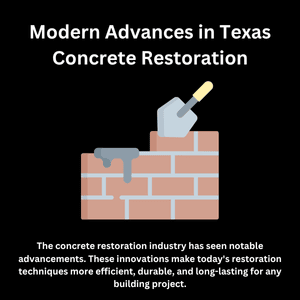
The concrete restoration industry has seen notable advancements. Contractors now use high-performance repair mortars that achieve high strength with minimal shrinkage, corrosion-inhibiting coatings, and flexible sealants. These innovations make today's restoration techniques more efficient, durable, and long-lasting for any building project in TX, whether it's a floor, driveway, or large commercial building.
Smart sensors can be embedded in concrete to monitor strain, crack growth, or moisture levels in real time. This technology is especially valuable in modern construction, allowing services to be tailored to each repair need. The industry is moving toward predictive maintenance rather than reactive approaches. Digital monitoring tools help contractors provide better services to customers and clients, ensuring longer-lasting results and reduced downtime.
From installation to repair, the push for better data means more precise planning and efficient workflows. When customers request a free quote, contractors can now offer data-informed recommendations that align with the building's needs. These innovations not only improve quality construction standards but also make installation and restoration services more streamlined for every type of repair project.
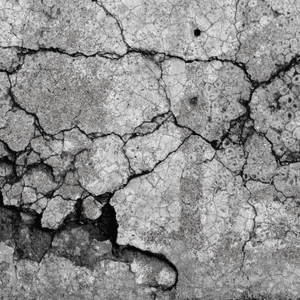
Being aware of warning signs helps you act early:
Concrete Cracks: Long or widening cracks - especially those 1/8 inch wide or larger - are clear signs to take action. Cracks in foundations or structural walls are particularly critical.
Uneven or Sunken Concrete: If concrete slabs aren't level, this shows underlying issues often due to soil settlement or erosion under slabs.
Spalling and Chipping: Spalling concrete looks like surfaces are flaking or chunks are breaking off, exposing aggregates or steel rebar beneath. This is a serious red flag that usually means concrete is deteriorating from within.
Surface Scaling: Sometimes concrete tops wear down in powdery or flaky ways from freeze-thaw action on poorly sealed concrete or from age and wear.
Pooling Water: If water pools in depressions on flat concrete, over time that water will penetrate and cause damage.
Many signs overlap or occur together. The key point is don't wait. If you catch issues early, concrete repair might be straightforward. If you wait until concrete pieces are falling off, restoration will be more extensive and expensive.
Concrete restoration protects the structural integrity of buildings, preserves beauty and usability of surfaces like walls, and saves money long term. In Texas, intense heat, occasional cold, and shifting clay soils mean concrete really benefits from proactive care.
Regular inspections can catch small issues before they escalate. If your concrete is showing age – cracked, stained, or uneven – consider restoration for your building, walls, or outdoor areas. With the right equipment and expertise, even deeply damaged concrete can be brought back to life.
Most Texas concrete restoration contractors provide free quotes and consultations. Many also offer services that include structural repairs, resurfacing, and sealing for added durability. By investing in concrete restoration, you're strengthening the very structure and foundation that supports your building, ensuring it remains durable, safe, and attractive for years to come.

